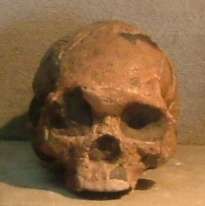Wajak crania

The Wajak crania (also Wadjak, following the French spelling of the toponym) are two fossil human skulls discovered near Wajak, a town in Malang Regency, East Java, Indonesia in 1888/90. Dubbed "Wajak Man", and formerly classified as a separate species (Homo wadjakensis), the skulls are now recognized as an early anatomically modern human fossil. They were dated to the early-to-mid Holocene (12,000 to 5,000 years ago) in the 1990s, but a 2013 study claimed a date between 28,000 and 37,000 years ago.[1] Their morphology has been described as proto-Australoid, or intermediate between Solo Man and contemporary Australo-Melanesians, possibly with Mongoloid admixture.[2]
See also
References
- ↑ Paul Storm, Rachel Wood, Chris Stringer, Antonis Bartsiokas, John de Vosa, Maxime Aubert, Les Kinsley, Rainer Grün, "U-series and radiocarbon analyses of human and faunal remains from Wajak, Indonesia", Journal of Human Evolution, Volume 64, Issue 5, May 2013, 356–365, doi:10.1016/j.jhevol.2012.11.002 "Laser ablation U-series dating results on human and faunal bone fragments from Wajak, Indonesia, indicate a minimum age of between 37.4 and 28.5 ka (thousands of years ago) for the whole assemblage. These are significantly older than previously published radiocarbon estimates on bone carbonate, which suggested a Holocene age for a human bone fragment". J. Krigbaum in: Habu et al. (eds), Handbook of East and Southeast Asian Archaeology (2017), p. 314.
- ↑ Peter Bellwood, Prehistory of the Indo-Malaysian Archipelago: Revised Edition (2007), 86ff.
- Storm, P., "The evolutionary significance of the Wajak skulls", Scripta Geol. 110 (1995) 1-247.
- Strom, P., Nelson, A. J., "The many faces of Wadjak Man", Archaeology in Oceania,
Volume 27, Issue 1 (April 1992), 37-46, doi:10.1002/j.1834-4453.1992.tb00281.x.
External links
- "Wadjak man", Merriam-Webster